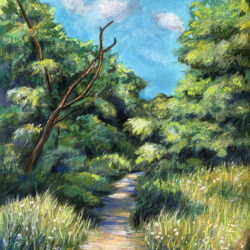Possibly the hardest thing to do as a watercolor painter is to give up trying to paint all the details – every little thing that you see with your eyes. The best, most interesting watercolor paintings in my opinion are those that capture the light of a subject or landscape and leave the details behind. Some really great watercolors just shine with light and show high contrast between light and dark. This is the goal I am trying for in my newer watercolor paintings.
This can be confusing to people who enter painting contests, especially watercolor contests, which often seem to reward artists who paint in hyperrealistic styles with every detail and reflection captured, like technical skill makes something art. It does not! That’s what a camera is for, and Photoshop. Painting in watercolor, a very special and fluid medium, is different and almost demands that an artist use the benefits of the water and the paper, bringing out the best in both, not treating the painting process as another way to make a photographic realistic image. (In other words, try not to learn anything about how to use watercolor from most painting competitions that award the most hyperrealistic paintings.)
Try the approach in these videos instead. I’m currently taking the course in the first video, because it’s almost as hard for me to leave behind “realism” as it is for other artists, and I’ve been doing it for years. My current focus in all my painting is impressionism, and abstract art. (This is a two minute clip from this instructional video at a random point.)
[arve url=”https://fineartsouth.net/wp-content/uploads/2023/02/Lights2.mov” title=”Paint the Light Video Excerpt” description=”Paint the Light Video” thumbnail=”95926″ /]And another video along the same lines is also valuable to watercolor painters who want to stop the hyper-realism.
Remember it’s important to stop valuing hyperrealism in watercolor art. Watercolor was never created to be used in a hyperrealistic manner, but it’s become a type of game for some painters to misuse watercolor in this way. It’s up to us to save watercolor and use it the way it was always intended to be used, and what it’s the best for – the fluid, unexpected things that water and paint do when combined.
Here is the finished painting from the video above. If you look at it for a few minutes you will notice that your brain fills in the details for you, the art does not have to spell everything out for you!






